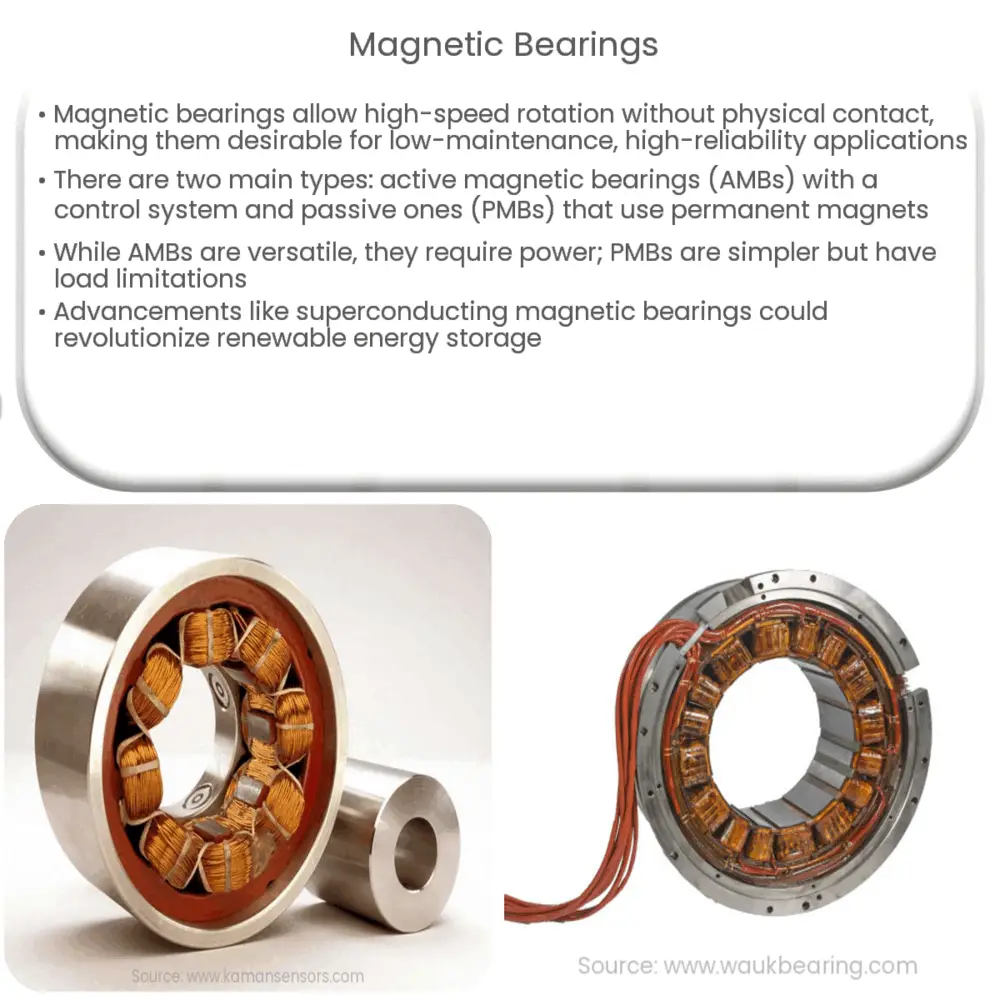Explore the world of magnetic bearings, their types, applications, and future developments in this comprehensive guide.

Magnetic Bearings: A Comprehensive Guide
Magnetic bearings are a fascinating innovation in the field of mechanical engineering. These are types of bearings that support high-speed rotation without any physical contact. The absence of friction and wear makes them highly desirable in numerous applications where low maintenance and high reliability are crucial.
Two key types of magnetic bearings are in common use today: active magnetic bearings (AMBs) and passive magnetic bearings (PMBs). Each type has its unique features and applications, which we will explore in depth.
Active Magnetic Bearings (AMBs)
Active magnetic bearings, as the name suggests, require an active control system to maintain stability. They employ a series of electromagnets around the rotor, which generate a magnetic field that levitates and positions the rotor within the stator. Sensors constantly monitor the rotor’s position and feed this information back to the control system, which adjusts the electromagnets’ output to keep the rotor in the correct position.
- Advantages: AMBs have the ability to handle high-speed rotations and can be used in vacuum environments. They also eliminate mechanical contact, thus reducing wear and tear and extending the equipment’s life.
- Disadvantages: The complexity of the control system and the need for a continuous power supply can be limiting factors. Additionally, a backup bearing system is typically required for scenarios when the power supply or control system fails.
Passive Magnetic Bearings (PMBs)
Unlike AMBs, passive magnetic bearings operate without any active control system or power supply. They rely on permanent magnets to create the magnetic field that levitates the rotor. The inherent repulsion or attraction between these magnets maintains the rotor’s position.
- Advantages: PMBs are simpler in design and do not require an external power supply, making them cost-effective and energy efficient. They are also highly reliable due to the lack of mechanical parts.
- Disadvantages: PMBs are limited in their load-carrying capacity, and stabilizing larger rotors can be a challenge. Also, the magnetic field of PMBs can be affected by temperature changes, limiting their applications.
In the next section, we will delve deeper into the applications of magnetic bearings, the advancements in the technology, and the impact of these breakthroughs on various industries.
Applications of Magnetic Bearings
Magnetic bearings find a broad range of applications in different industries due to their unique characteristics. In the energy sector, they are used in turbines and compressors to increase efficiency and reduce maintenance costs. In the aerospace industry, they are applied in flywheel energy storage systems, satellite reaction wheels, and gyroscopes due to their capability to function in vacuum conditions.
The medical field also benefits from this technology. High-speed centrifuges and medical scanners, for instance, rely on magnetic bearings for smooth and noiseless operation.
Future Developments and Impact
Research and development in the field of magnetic bearings continue to push the boundaries of what’s possible. For instance, the advent of superconducting magnetic bearings has opened up new possibilities. These bearings use superconducting coils, which can carry large amounts of current without resistance, thus creating a stronger magnetic field.
The potential of superconducting magnetic bearings is immense, particularly in the field of renewable energy. They can be utilized in high-capacity flywheel energy storage systems, a promising solution for storing surplus renewable energy.
Conclusion
In conclusion, magnetic bearings represent a significant leap forward in engineering technology. With their ability to eliminate mechanical contact and reduce wear and tear, they have become an integral part of many industries, significantly enhancing the efficiency and longevity of various systems.
The future of magnetic bearings looks even brighter, with ongoing advancements such as superconducting magnetic bearings promising to unlock new frontiers in renewable energy and beyond. As research progresses, we can expect to see magnetic bearings playing an increasingly central role in our technologically advanced society.

